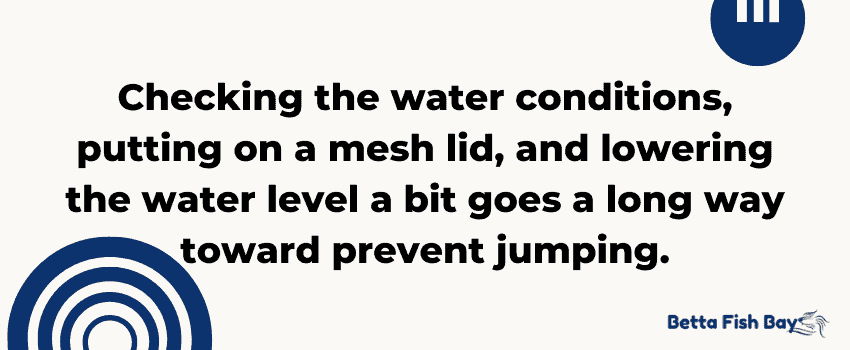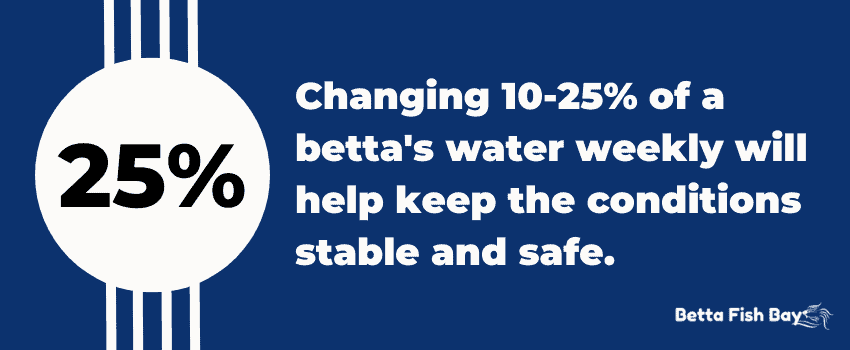Looking into your aquarium and not seeing your betta is quite alarming.
If you cannot find your betta in its usual hiding spots, think outside of the tank.
Bettas can jump 2-3″ inches high, and they don’t always land back in the water.
So, is betta fish jumping a common behavior?
Betta fish jumping is common, and there are a variety of reasons why they do it. The major reason bettas jump out of their tank is poor water conditions. Other causes include lack of space, stress from tank mates, and a poor diet. Bettas also get jumpy during mating season.

Table of Contents
The Natural Instinct of Betta Fish to Jump
An Evolutionary Edge: Breathing Air
Betta fish come equipped with a unique feature called the labyrinth organ, a bit like the lungs in our chest. It enables them to gulp both water and surface air.
This evolutionary marvel allows these aquatic acrobats to survive in oxygen-starved environments, such as rice paddies or shallow ponds.
Leap to Safety: Escaping Predators
When faced with larger, more aggressive species, betta fish don’t swim for dear life—they leap for it!
This out-of-the-water escape act is possible because of their trusty labyrinth organ.
Jumping helps bettas evade predators and breathe air until they can safely return to the water.
On the Hunt: Finding Food
Bettas aren’t particularly fussy eaters.
They won’t shy away from a quick airborne adventure if it means nabbing a tasty insect near the water’s surface.
This dynamic jump not only guarantees a meal but also adds a protein punch to their diet.
An Aquatic Journey: Reaching New Waters
Stagnant or overcrowded conditions can make a betta fish’s small puddle unlivable. This could increase ammonia levels, causing harm to the betta.
These daring fish might opt to jump, exploring new habitats and escaping polluted waters.
A betta’s labyrinth organ makes even the smallest of puddles a temporary home. But if there’s a chance for more spacious or cleaner waters, you bet they’ll take it.
Some Benefits of Jumping for Betta Fish
Just as humans benefit from a robust workout, bettas thrive with physical exertion.
Their full-body leaps not only flex their tiny, muscular bodies but also fuel their blood circulation. Think of it as their version of a high-intensity interval training session!
But betta fish aren’t just about physical fitness. They have an emotional side too!
By leaping out of the water, they get a much-needed dose of mental and physical stimulation. This keeps them at bay from the boredom and stress of captivity.
Finally, the jump isn’t just for exercise or stimulation—it’s a gateway to exploration. It allows bettas to venture beyond their aquatic boundaries, satiating their innate curiosity.
5 Common Causes of Betta Fish Jumping in Captivity

Betta fish are notorious escape artists.
Sometimes, their attempts to leap out of their tanks are spurred by certain conditions within their aquatic environment.
Knowing these triggers and managing them can keep your betta happy and safe within the confines of their tank.
1. Poor Water Quality
Among the most common factors causing betta fish to jump is a lack of clean water. Simply put, when their home starts to feel uncomfortable, they seek better living conditions.
A neglected aquarium could turn into a toxic stew with poor maintenance. Leftover food, fish waste, and rotting organic matter can lead to a dangerous accumulation of ammonia and nitrite.
Ammonia levels above 0 ppm can cause ammonia poisoning.
These perilous substances attack a betta’s gills, skin, eyes, and internal organs, wreaking havoc over time. A lethal outcome isn’t off the table with prolonged exposure, especially for the average betta.
The toxicity might drive your healthy betta to gasp for air or show signs of lethargy. In extreme cases, they might even attempt a daring leap out of their noxious home.
Betta fish flourish in a pH range of 6.5 to 7.5 and temperatures hovering between 78-80° degrees Fahrenheit (25.5-27° C).
Ideal Water Parameters for a Betta Fish Tank Include the following:
- Temperature: 78-80° degrees Fahrenheit (25.5-27° C)
- pH: 6.5-7.5
- Ammonia and Nitrite: 0 ppm
- Nitrate: < 40 ppm
- gH: 3-4 dGH (50-66.7 ppm)
- kH: 3-5 dKH (53.6-89.4 ppm)
- Minimum Tank Size: 5 Gallons
Abrupt or severe variations can induce considerable stress in your betta. This increases the risk of shock or sickness.
Just as we crank up the AC when the mercury rises, bettas may leap out of their tanks in search of more comfortable conditions.
Residing in a suboptimal water environment wears down your betta’s immune defenses. This makes them susceptible to an array of bacterial, fungal, parasitic, and viral afflictions.
You might spot signs of common fish maladies like:
- Fin rot
- Ich
- Velvet
- Dropsy
- Popeye
- Swim bladder disorder
If your betta is frequently under the weather, it might risk a leap for a shot at a healthier environment.
2. Inadequate Tank Size or Shape
The size and shape of a fish tank affect a betta’s well-being.
Imagine a tiny, narrow tank like a cramped studio apartment. Anyone, even a fish, would feel cooped up and bored. Here’s why:
Reduced Swimming Area
Betta fish are natural swimmers who love to explore their surroundings.
A small or narrow tank is akin to a one-lane road during peak traffic hours—there’s just no room to move. This lack of space can lead to a stressed, frustrated, and eventually, a bored betta fish.
Increased Waste Concentration
Nobody wants to live in a messy home, do they? A compact or narrow tank can heighten the concentration of waste and toxins in the water due to the limited amount of water it holds.
This situation could diminish water quality and jeopardize your fish’s health. Cloudy water might even obstruct the view of your aquatic buddy.
Limited Enrichment Options
Just like us, betta fish appreciate a stimulating living environment. They enjoy having plants, decorations, hiding places, and toys in their habitat.
A small or narrow tank can limit these options, leading to less mental and physical engagement. Over time, this could result in a bored and stressed betta fish.
3. Unsuitable Tank Mates or Decorations
Creating the perfect environment for your betta fish can make a world of difference in their behavior and well-being. But certain elements in this habitat can create more tension than tranquility.
Bettas have a reputation for being territorial and aggressive.
If you pair them with guppies or angelfish, it’s akin to adding fuel to a fire. These fish types share the betta’s assertive nature, which can lead to a battle for food and personal space.
Should your betta fish feel threatened, it might take drastic action by leaping out of the tank. Their world needs to feel safe, spacious, and stress-free.
It’s best to review all betta tank mate species before adding them in.
Another aspect to consider is the potential for decor-related injuries.
A betta’s delicate fins are more prone to tearing.
Tank decorations with rough or pointed edges pose a risk.
If you notice that your betta is jumping or displaying signs of stress, take a closer look at its surroundings. Review the tank environment, ensuring it is a haven for your betta rather than a source of strife.
4. Overfeeding or Underfeeding
When it comes to keeping betta fish healthy, getting their feeding schedule just right is key.
Overfeeding or underfeeding can impact a betta’s health and behavior. This may cause some pretty out-of-character actions like jumping!
Below are some common issues in bettas caused by improper feeding.
Bloating and Constipation
Overfeeding your betta fish can cause a pile-up of waste and toxins in their digestive system.
The result? Bloating, constipation, and one very uncomfortable fish.
It’s not just a fishy bellyache, though. Bloating and constipation also cause issues like swim bladder disorder, fatty liver, or dropsy.
Poor Water Quality
Leftover food and excess waste from overfeeding can compromise your water quality.
The build-up of ammonia and nitrite, low oxygen and pH levels, and even an increase in fin rot and algae blooms can all stem from overfeeding.
Weight Loss and Malnutrition
On the other side of the coin, underfeeding can cause your betta fish to lose weight and muscle mass. This leaves your betta weak and susceptible to illness.
Nutrient and vitamin deficiencies can lead to a weakened immune system, dull coloration, and life-threatening weight loss.
5. Breeding Behavior or Mating Season
When it comes to the jumping tendencies of betta fish, the influence of breeding behavior or mating season is noteworthy.
So, why are betta fish, especially males, turning into aquatic acrobats during this time?
Betta fish are the loners of the fish world, only socializing to mate.
This solitude triggers a quest for companionship. Male bettas may leap from their tank in search of potential mates or more favorable breeding conditions.
Our little friends are also quite the architects. Male betta fish construct intricate bubble nests on the water’s surface to safeguard their offspring.
In their pursuit of a perfect nest, they may jump out of the water to gather air bubbles or plant materials.
They may also leap to ward off predators or intruders threatening their aquatic nursery.
Who knew betta fish were such romantics? Their courtship and mating processes involve elaborate dances and displays of affection.
The males might jump out of the water to impress or attract females. Female betta fish might jump to signal their readiness or acceptance of the courtship.
During mating season, you might notice your betta fish jumping more than usual.
How to Prevent Betta Fish from Jumping Out of the Tank

The well-worn adage “prevention is better than cure” holds particular relevance when discussing betta fish.
Below, we’ll explore practical methods to help ensure your betta fish remains safely within its tank.
Securing the Tank with a Lid or Mesh
One straightforward solution to discourage your betta fish’s escapades is securing the tank with a lid or a mesh cover.
Imagine this as a roof for your fish’s aquatic home, serving as a barrier against potential escape attempts. A lid or a mesh prevents your betta from ending up on the floor, where it might risk drying out, suffocating, or encountering a household pet.
Besides offering security, a lid or a mesh helps manage water evaporation and heat loss. This helps maintain the water’s quality and, ultimately, your betta’s health.
A humid environment above the water surface is crucial for preventing a betta’s labyrinth organ from drying out. This ensures your betta’s respiratory health.
Incorporating a lid or mesh lowers the risk of your betta taking an ill-advised leap.
Lowering the Water Level
In the world of betta fish care, you’ll quickly learn these dazzling creatures have a knack for jumping. To prevent this, another method involves creating a buffer zone by lowering the water level.
While betta fish are known for their adventurous spirit, they’re not exactly world-class high jumpers.
By reducing the water level in your tank, you increase the distance they need to cover to jump out. Essentially, it’s akin to asking them to leap over a hurdle instead of a mere step.
Such a feat demands more strength, speed, and precision from your betta. Decreasing the water level by 1-2″ inches can significantly diminish the likelihood of successful jumps.
Betta fish can have their curiosity quelled by lowering the water level, which restricts their view.
Imagine it like slightly lowering the blinds in your room. Your betta can’t see what’s happening outside or above the tank.
As a result, the fish is less likely to get tempted by external stimuli. This reduces the chance of it attempting a leap.
Providing Enough Stimulation and Enrichment for Betta Fish
If boredom or frustration sets in, your betta fish may develop a surprising talent for high jumps!
Providing a wealth of stimulation and enrichment isn’t just about keeping your betta entertained. It also helps curb their acrobatic tendencies.
In the wild, betta fish live in slow-moving, shallow waters abundant with vegetation. So, mimicking this natural habitat in your aquarium offers a sense of comfort and security to your aquatic pet.
Bettas value a fair share of hiding spots. Live plants, caves, and pieces of driftwood all make excellent options for these secretive spaces.
Introducing enrichment activities also stimulates your betta’s natural instincts for hunting and playing. This not only ensures physical engagement but also contributes to their mental stimulation.
Here are some great enrichment activities to consider:
- Introducing live foods
- Incorporating mirrors
- Using Ping-pong balls
- Adding moss balls
Maintain a Clean Betta Tank

Maintaining a clean and comfortable environment for your betta can curb jumping behavior.
Regular water changes help reduce waste and toxins. Depending on your tank size and its filtration, you’ll want to change 10% to 25% of the water weekly or bi-weekly.
Always use dechlorinated water and ensure the temperature matches your tank’s temperature.
Keep tabs on your water’s ammonia, nitrite, nitrate, and pH levels by using a liquid-based test kit or test strips.
Do this at least once a week or whenever you notice signs of stress or disease in your fish. If something’s off, consider a water change.
Filters are like the kidneys of your betta tank—they help clear out physical and chemical waste.
They also aid in biological filtration. This is where good bacteria break down harmful ammonia and nitrite into less harmful nitrate.
While filters also oxygenate the water and create water movement, beware of ones with strong currents or bubbles. After all, bettas are lovers of calm, still waters.
The addition of aquatic plants also helps in keeping the fish tank clean and enhances the environment for your betta.
Choose the Right Tank Size and Shape
A five-gallon tank is the bare minimum for a betta fish tank, but bigger is always better. Choosing a larger tank provides more swimming space, better water quality, and more room for those fancy decorations.
Larger tanks can reduce the stress and aggression of your betta fish as they have more room to call their own.
Betta fish are not great vertical swimmers; they prefer the horizontal route. Plus, they need easy access to the surface for breathing air.
A rectangular or square aquarium design is your best bet for a betta. Sorry, no round fishbowls here.
The native habitats of bettas are the shallow waters of rice paddies, ponds, and swamps. They feel most at home in a tank resembling these habitats.
A wide and shallow tank gives them the visibility, comfort, and security they need. So think more panoramic landscape, less deep-sea abyss.
Choose Safe Tank Mates and Decorations
Before you consider rehoming your betta or tossing out all your decor, don’t panic. There are ways of avoiding these issues.
The best roomies for bettas are the quiet types. Excellent tank mates for a betta include:
- Pygmy corydoras
- Otocinclus catfish
- Mystery snails
- Amano shrimp
These little guys won’t bother your betta, and they won’t hog the food or space.
There are a few precautions betta owners must take when introducing plants, decorations, and enrichment activities to their fish tank.
Below are some helpful tips for keeping your betta fish safe.
Choose Suitable Plants and Decorations
Choose live or silk plants without sharp edges or chemicals. Also, they should provide enough cover and space for the fish to swim around comfortably.
Inspect tank decorations for peeling paint and rough surfaces, which could harm your betta. Avoid decorations with small holes or nooks where your betta might get stuck.
Choose Appropriate Toys
The toys you provide should be appropriate for betta fish.
They should be small enough for your fish to fit in their mouth. But avoid toys your betta could swallow whole.
Ensure the toys are safe and clean for the fish and the water quality.
Remove toys after use or replace them regularly. This helps prevent algae growth or mold formation.
Do Not Overstimulate or Stress Your Betta
Betta fish, like us, don’t appreciate too much of a good thing.
Offer stimulation and enrichment in moderation and variety. This includes a balanced light routine to maintain their circadian rhythm.
Avoid constant or excessive stimulation, and watch your fish for any signs of stress or disease, such as:
- Clamped fins
- Faded colors
- Loss of appetite
- Abnormal swimming
Provide a Proper Diet
To keep your betta fish happy and healthy, there are a few feeding guidelines.
Choose high-quality betta fish pellets with a protein content of 35% or more. Add variety to your betta’s diet by supplementing with live foods a couple of times during the week.
These healthy betta food options provide the right balance of protein, fiber, vitamins, and minerals.
Replace them at least every six months to ensure they’re fresh.
Mimic their natural feeding habits by offering meals once in the morning and once in the evening. This prevents your betta from going hungry or overeating.
Choose one day per week for fasting your betta. A fasting day lets your betta digest leftover food in its stomach and prevents constipation and bloating.
Practice portion control by only feeding as much as your betta can finish within two minutes. This helps prevent overfeeding and waste.
Two to four pellets per meal are sufficient. A betta’s stomach is only the size of its eyes.
What to Do If Your Betta Fish Jumps Out of the Tank

Suppose you’ve found your betta out of its aquatic home.
What do you do? How do you help them recover from such an escapade?
Let’s dive right into some lifesaving steps you must take if your betta fish takes a leap of faith out of the tank.
Act Quickly and Gently
Time is of the essence when your betta fish lands on the dry side of life. Acting fast can increase your betta’s chance of survival.
Let’s break it down:
Check For Signs of Life
Spot your fish on the floor? Don’t panic just yet.
Bettas can live for up to two hours out of the water, depending on where they land!
Check for any signs of life. This includes movement, breathing, or the occasional blink.
If your betta shows signs of life, there’s hope! If not, unfortunately, it may be a little too late for our aquatic adventurer.
Use a Soft Net or a Wet Cloth
Got a pulse? Fantastic!
Now, the goal is to get your betta back into clean water as soon as possible.
But here’s the catch: don’t use your bare hands. You might harm their slime coat, scales, or even gills.
Instead, use a soft net or a wet cloth. Remember, no squeezing, no rubbing, and definitely no tossing them back into the tank.
Avoid Touching the Gills or Scales
If for some reason you have to touch your betta, steer clear of the gills or scales.
They’re super delicate and sensitive, and any contact could mess with their breathing or lead to infections.
Instead, touch your betta gently by the tail or body. It’s like a polite fish handshake.
Return Your Betta Fish to the Tank or a Quarantine Tank
Time is of the essence when it comes to getting your betta back into the water.
While you must act fast, your betta’s safety is also important.
The following tips help you return your betta to the water without causing more harm.
Use the Acclimation Process
Imagine diving into a pool without testing the water first – pretty shocking, right? Now picture your betta doing the same thing, but multiply the shock factor.
For betta fish, proper acclimation is a matter of life and death.
If your betta has been out of the water for a while, use an acclimation process.
Acclimation involves floating your fish in a small container with some tank water in the main tank for 15 to 30 minutes. This gives your betta time to adjust to the water temperature and chemistry and reduces the risk of further shock or stress.
You may speed up this process by adding a little water from the betta fish tank to the container every few minutes.
Trust me, your betta will thank you for the gentle reintroduction.
Add Stress Coat or Aquarium Salt
Next, it’s time to treat any possible injuries your betta may have sustained during its brief moment of freedom.
This is where a stress coat or aquarium salt comes in.
If your betta needs any type of medication, place your fish in a quarantine tank instead of its home tank.
A stress coat water additive can help protect and repair your betta’s slime coat, gills, and scales. This keeps your betta fish comfortable as it recovers.
Aquarium salt can reduce inflammation, infection, and parasites in fish. It’s like a salt bath, but for fish – and a lot more helpful.
Just be sure you follow the instructions on the product label for the right dosage and frequency.
Watch for Signs of Infection
Always watch your betta for signs of infection following an out-of-water ordeal. These underlying issues demand attention.
Signs of infection include:
- Redness
- Pus
- Swelling
- Clamped fins
- Faded colors
- Loss of appetite
- Unusual swimming patterns
If you notice any of these signs, treat your betta with the appropriate medication or consult a qualified veterinarian.
Monitor Water Parameters
Now, to ensure a complete recovery, we need to do a bit of housekeeping. Or should I say, tank-keeping?
When your betta jumped ship, it may have exposed itself to poor water quality or contaminants.
You must check the water parameters in the tank or quarantine tank and ensure they are optimal for your betta.
Using a water testing kit, measure the pH, ammonia, nitrite, and nitrate of the water. Regular water changes and a reliable filter can help maintain these optimal conditions.
Keeping Your Betta From Jumping Ship
Jumping is a common behavior for betta fish, as it is a part of their natural instincts.
While jumping is fine for wild bettas, this behavior can put captive bettas in great danger.
Putting a lid or mesh cover on your betta tank can prevent your fish from escaping. Lowering the water level is another excellent deterrent to this behavior.
If you do find your betta outside of its tank, don’t panic. Your betta fish can still survive the ordeal with the right emergency treatment.


